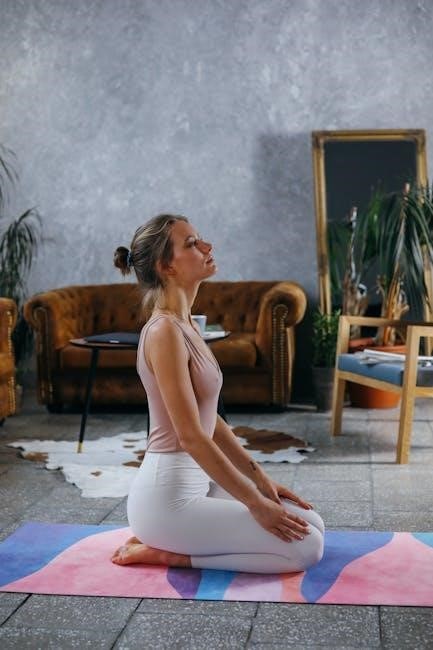Vinyasa Flow Yoga is a dynamic practice linking breath with movement, emphasizing fluid transitions between poses. It cultivates physical strength, mental clarity, and a deep mind-body connection.
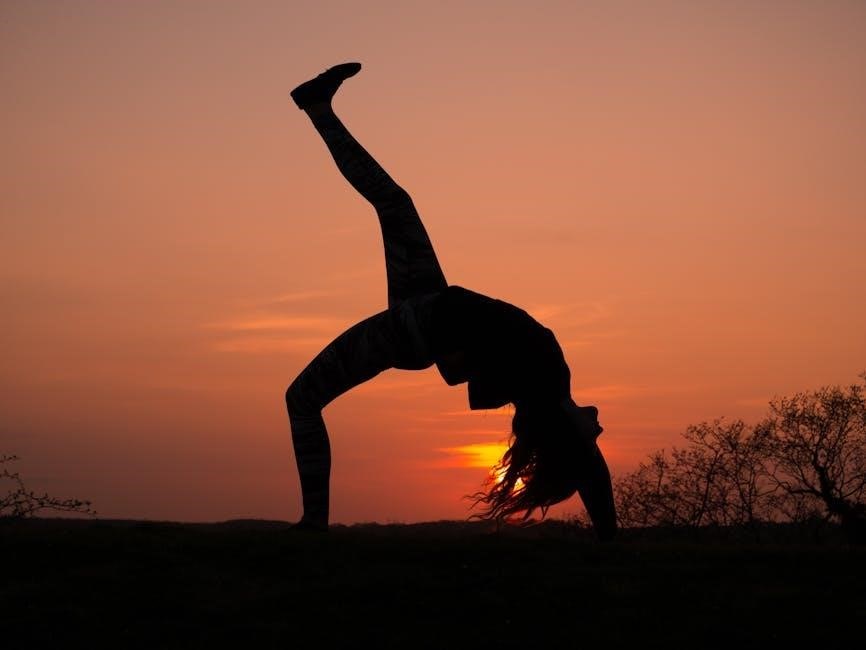
History and Evolution of Vinyasa Flow
Vinyasa Flow Yoga traces its roots to ancient Indian yoga traditions, evolving from the teachings of Krishnamacharya in the early 20th century. The term “Vinyasa” refers to the synchronization of breath with movement. This dynamic style gained popularity in the West through teachers like Pattabhi Jois and B.K.S; Iyengar, blending Ashtanga Yoga’s intensity with creative sequencing. Over time, it adapted to modern practices, emphasizing fluid transitions and personal expression, making it a versatile and widely practiced form today.
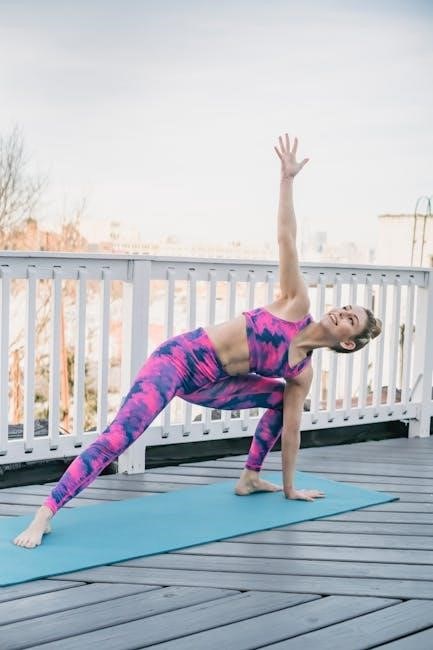
Benefits of Vinyasa Flow Yoga
Vinyasa Flow Yoga enhances flexibility, balance, and strength while improving cardiovascular health and mental clarity. Its dynamic nature promotes stress reduction and overall well-being, making it a holistic practice beneficial for all levels.
Physical Benefits
Vinyasa Flow Yoga enhances flexibility, strength, and cardiovascular health through dynamic movements. It improves circulation, tones muscles, and boosts endurance. Regular practice increases range of motion, balances body alignment, and supports weight management. The flowing sequences also enhance coordination and posture, while the breath-synchronized movements promote detoxification and overall physical well-being.
Mental and Emotional Benefits
Vinyasa Flow Yoga cultivates mindfulness, reducing stress and anxiety by synchronizing breath with movement. It enhances emotional balance, fostering self-awareness and inner peace. The flowing sequences promote mental clarity, focus, and a sense of calm. Regular practice helps build resilience, improves mood, and encourages a positive outlook, contributing to overall mental and emotional well-being.
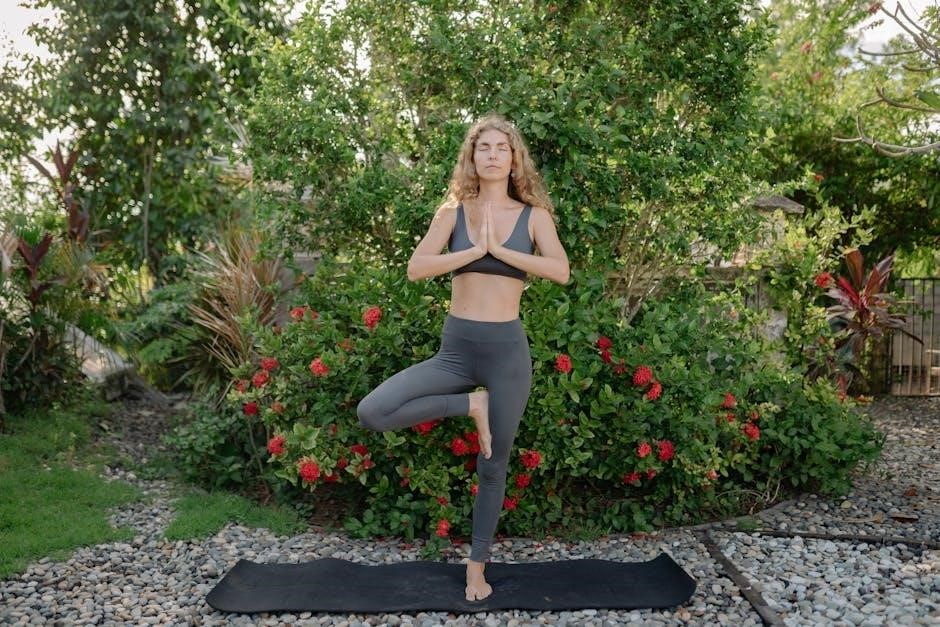
Principles of Sequencing a Vinyasa Flow Class
Sequencing involves creating a logical flow that prepares the body for poses, balances energy, and connects movement with breath, ensuring a safe and transformative experience.
Understanding the Basics of Vinyasa Flow Sequencing
Vinyasa Flow sequencing begins with synchronizing movement and breath, ensuring each pose flows naturally into the next. Start with foundational postures, building heat and flexibility gradually. Key elements include proper warm-up, peak poses, and a cooling sequence to enhance balance and energy. Focus on alignment, breathing techniques, and transitions to create a harmonious practice. This approach ensures safety and progression for all levels.
Creating a Dynamic Flow
A dynamic Vinyasa Flow is crafted by varying pace, intensity, and pose sequences to keep the practice engaging. Incorporate a mix of standing, seated, and balancing postures, linking them seamlessly with breath. Use transitions like vinyasa or flowing movements to maintain rhythm. Peaks and valleys in sequencing ensure a balanced practice, catering to diverse energy levels and goals. This approach fosters fluidity and adaptability in class design.
Balancing Energy and Intensity
Balancing energy and intensity ensures a well-rounded practice, preventing burnout or stagnation. Alternate between dynamic flows and calming poses to maintain equilibrium. Incorporate active holds for strength and passive holds for relaxation. Use restorative poses to recharge energy. This approach honors individual needs, fostering a sustainable and transformative practice that nurtures both body and mind.
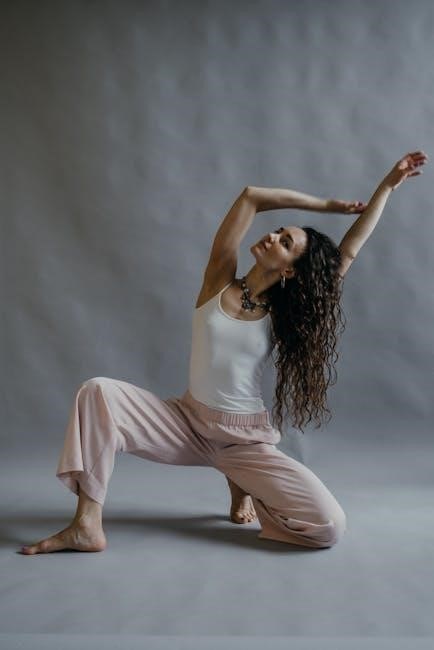
Structuring a Vinyasa Flow Class
A well-structured class begins with a warm-up, progresses through a dynamic flow, and concludes with a cool down and final relaxation to promote balance and renewal.
Warm-Up and Preparation
A Vinyasa Flow class begins with gentle movements to awaken the body, such as neck rolls, shoulder stretches, and cat-cow sequences. Sun Salutations are often introduced to build heat and fluidity. Breathing techniques like Ujjayi are emphasized to connect movement with breath, ensuring a mindful and grounded practice from the start. This preparation sets the foundation for a smooth and intentional flow. Proper warm-up prevents injury and enhances flexibility, making it essential for all levels of practitioners to ease into the practice gradually and safely.
Main Sequence and Flow
The main sequence is where the dynamic flow peaks, building on the warm-up. It typically includes Sun Salutations, followed by standing poses like Warrior I and II, and balancing poses such as Tree or Eagle. Breath-synchronized movements guide transitions, maintaining fluidity. This segment may incorporate backbends, twists, or seated poses, depending on the theme. The flow is designed to challenge strength, flexibility, and focus while fostering a meditative state through continuous breath awareness and movement connection.
Cool Down and Final Relaxation
The cool down phase transitions from dynamic flow to calm, preparing the body for rest. Gentle stretches, seated forward folds, and twists are common, followed by inversions like Legs-Up-The-Wall. Deep breathing exercises calm the mind, leading to final relaxation in Savasana. This concluding segment rejuvenates the body, quiets the mind, and seals the practice’s benefits, fostering a sense of balance and inner peace.
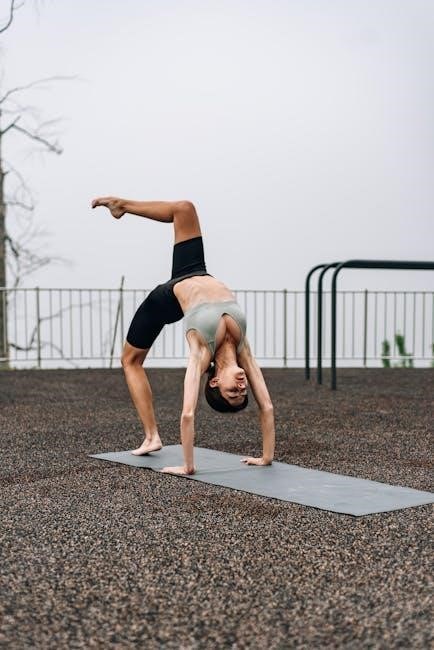
Modifications for Different Levels and Needs
Modifications in Vinyasa Flow Yoga ensure accessibility for all levels, injuries, or goals. Props, pose variations, and mindful sequencing create a safe, inclusive practice environment.
Adjustments for Beginners
Beginners benefit from simplified poses, slower pacing, and foundational focus. Use props like blocks or straps to modify postures. Prioritize proper alignment and breath awareness. Short holds and gentle flows help build strength and flexibility. Detailed cueing ensures safety and understanding. Encourage rest when needed and provide modifications for challenging poses to foster confidence and gradual progression in their practice.
Enhancements for Advanced Practitioners
Advanced practitioners can explore complex sequences, deeper backbends, and inversion variations. Incorporate advanced breathing techniques like pranayama and bandha work. Dynamic flows with rapid transitions and balancing poses challenge coordination and focus. Longer holds in poses refine strength and endurance. Refining alignment and subtle adjustments enhance practice depth, while incorporating meditation or mantra adds a spiritual dimension for a holistic experience.
Accommodating Injuries and Special Conditions
When creating a Vinyasa Flow sequence for those with injuries or special conditions, prioritize modifications and substitutions. Use props like blocks, straps, or blankets to support safe postures. Avoid poses that may exacerbate injuries, such as deep twists for spinal issues or weight-bearing poses for joint problems. Offer gentle alternatives and encourage rest when needed. For conditions like pregnancy or chronic pain, design sequences that promote stability and comfort, ensuring accessibility and safety for all practitioners.
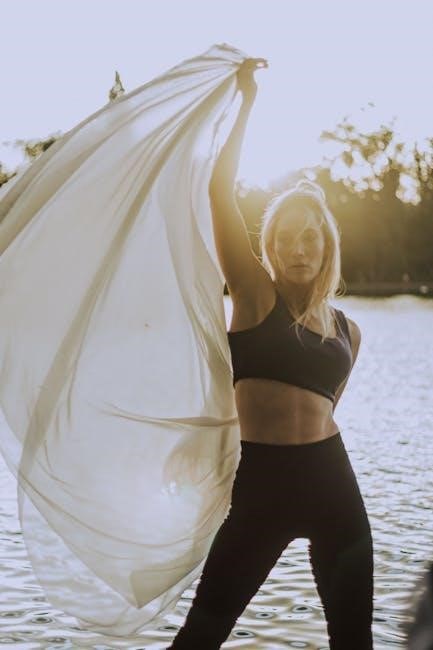
The Role of Breath in Vinyasa Flow
Breath is the foundation of Vinyasa Flow, linking movement with mindfulness. It guides the practice, maintains rhythm, and enhances physical and mental benefits, optimizing the flow experience.
Ujjayi, or “ocean breath,” is a foundational technique in Vinyasa Flow. Practiced by slightly closing the glottis, it creates a soft hissing sound. This breath is used throughout the sequence to synchronize movement, maintain rhythm, and promote relaxation. It helps calm the mind, regulate energy, and connect the body with each pose, enhancing the flow experience and fostering mindfulness in practice.
Synchronizing Movement with Breath
Synchronizing movement with breath is the core of Vinyasa Flow. Each pose transitions smoothly with an inhale or exhale, creating a flowing rhythm. This connection enhances concentration, ensures fluidity, and balances energy. Proper synchronization deepens the practice, linking physical movement with mental focus, and promotes a meditative state throughout the sequence.
Advanced Breathing Techniques
Advanced breathing techniques in Vinyasa Flow include Kapalabhati (breath of fire), Bhastrika (bellows breath), and Nadi Shodhana (alternate nostril breathing). These practices enhance energy, detoxify, and balance the nervous system. Incorporating these into sequences amplifies mental clarity, physical endurance, and meditative states. They are often used in dynamic flows to deepen the practice and prepare for advanced postures or meditation, fostering a harmonious body-mind connection;
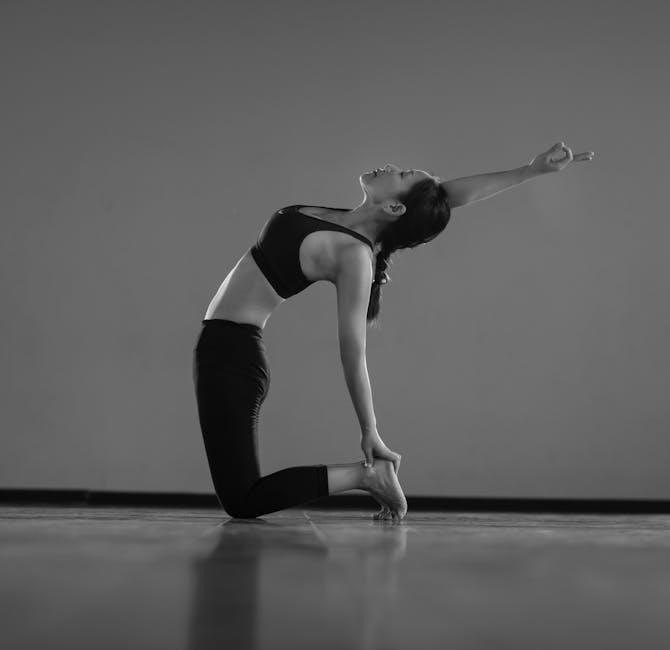
Common Vinyasa Flow Sequences
Common Vinyasa Flow sequences include foundational flows linking movement with breath, building internal heat, strength, balance, and flexibility. These sequences vary, serving purposes like detoxification, energy, or relaxation, promoting well-being.
Sun Salutations (Surya Namaskar)
Sun Salutations, or Surya Namaskar, are a foundational sequence in Vinyasa Flow Yoga, combining movement with breath. This dynamic flow includes poses like Mountain, Forward Fold, Plank, Upward Dog, and Downward Dog. It improves flexibility, strength, and circulation, while warming up the body. Each movement is synchronized with inhalations and exhalations, fostering a meditative connection between body and breath. Variations exist, but the core sequence remains a energizing and centering practice.
Standing and Balancing Poses
Standing and balancing poses in Vinyasa Flow Yoga enhance strength, stability, and focus. Poses like Warrior II, Tree Pose, and Eagle Pose strengthen the legs and core, improving balance. These sequences also cultivate mental concentration and body awareness. Incorporating breath synchronization, they prepare the body for more dynamic flows while promoting grounding and equilibrium. Regular practice boosts overall physical and mental steadiness.
Seated and Forward Folding Sequences
Seated and forward folding sequences in Vinyasa Flow Yoga are designed to stretch the hamstrings, spine, and hips while promoting relaxation and improving circulation. Poses like Seated Forward Bend and Head-to-Knee Pose enhance flexibility and release tension. Synchronizing breath with movement deepens stretches and maintains focus, transitioning smoothly from dynamic flows to a cooler, more restorative practice, benefiting both body and mind.
Backbends and Twists
Backbends and twists in Vinyasa Flow Yoga enhance spinal flexibility, open the chest, and detoxify the body. Poses like Cobra, Camel, and Seated Spinal Twist boost energy flow and improve posture. These sequences strengthen back muscles and prepare the body for deeper movements. Proper alignment is key to avoid injury, ensuring safe and effective practice while fostering balance and vitality in the body. Breathing deeply enhances their benefits.
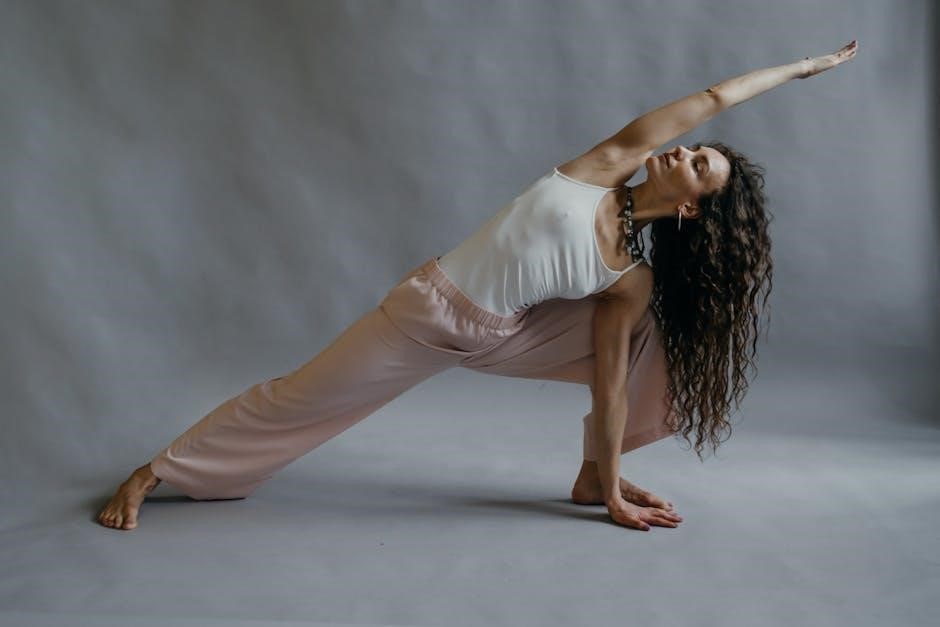
Using Vinyasa Flow Yoga Sequences PDFs
Vinyasa Flow Yoga Sequences PDFs provide structured, organized, and accessible plans for classes. They include poses, breathing techniques, and timing, serving as valuable resources for teachers and practitioners to ensure smooth, effective, and consistent flows. Visual guides enhance understanding and execution, making them indispensable tools for both teaching and personal practice. They simplify planning and execution.
Benefits of Using PDF Guides
Vinyasa Flow Yoga Sequence PDFs offer convenience, accessibility, and consistency. They provide clear, visual guides for poses, sequences, and breathing techniques, aiding teachers in lesson planning and students in following along. PDFs are easily shareable and printable, making them ideal for home practice or classroom use. They also ensure continuity, helping practitioners maintain a structured and progressive approach to their yoga journey.
How to Create Your Own Sequence PDF
To create a Vinyasa Flow Yoga Sequence PDF, start by planning the sequence, choosing poses that align with a specific theme or goal. Use design tools like Canva or Adobe Illustrator to layout the content. Include clear instructions, visuals, and breathing cues. Optimize for readability by using headings, bullet points, and images. Save the final design as a PDF for easy sharing and printing.
Recommended Resources for Download
Explore reputable websites like DoYouYoga and Yoga International for high-quality Vinyasa Flow Yoga sequence PDFs. These platforms offer a variety of downloadable resources, including pose guides, class plans, and thematic flows. You can also find customizable templates on platforms like Etsy or creative marketplaces. Additionally, many yoga studios provide free PDF sequences on their websites for practitioners to follow at home.
Tips for Teaching Vinyasa Flow Yoga
Provide clear cues, demonstrate poses, and encourage students to listen to their breath. Maintain a steady pace, offer modifications, and create a safe, inclusive environment for all levels.
Cueing and Alignment
Clear cueing ensures students understand transitions and poses. Use anatomical language for precision, guiding breath synchronization. Hands-on adjustments enhance alignment, preventing injuries and deepening practices. Encourage awareness of proper positioning to optimize benefits and safety, fostering mindfulness in every movement for a balanced and effective flow experience.
Maintaining Class Pacing
Class pacing ensures a smooth, engaging experience. Start with slower sequences to warm up, then gradually increase intensity. Balance dynamic flows with calm pauses to allow recovery. Timing transitions with breath synchronization keeps the rhythm natural. Varying pose durations maintains interest while respecting students’ capacities, fostering a cohesive and energizing practice from start to finish.
Encouraging Mindfulness and Presence
Encourage mindfulness by guiding students to focus on breath and movement connection. Use cues to remind them to stay present, observe sensations, and let go of distractions. Emphasize the importance of transitions, fostering awareness in every moment. Create a calming atmosphere, allowing students to deepen their practice and connect with their inner selves through intentional, mindful flow.
Thematic Vinyasa Flow Sequences
Encourage mindfulness by guiding students to focus on breath and movement connection. Use cues to remind them to stay present, observe sensations, and let go of distractions. Emphasize the importance of transitions, fostering awareness in every moment. Create a calming atmosphere, allowing students to deepen their practice and connect with their inner selves through intentional, mindful flow.
Hips and Shoulders Opening
Focus on releasing tension in the hips and shoulders through targeted flows. Incorporate poses like Warrior II, Triangle Pose, and Seated Forward Fold for hip opening. For shoulders, include Downward Dog, Cobra Pose, and gentle twists to enhance mobility. Use dynamic stretches and holds to deepen release, improving flexibility and range of motion. This sequence enhances overall flow and promotes relaxation, making it ideal for stress relief and improved posture.
Balance and Core Strength
Strengthen your core and improve balance with poses like Plank, Chaturanga, and Boat Pose. Incorporate Eagle Pose and Tree Pose to enhance focus and stability. These sequences build internal heat and stamina while refining alignment. Practice transitions between balancing postures to cultivate mindfulness and physical awareness. This flow prepares the body for more challenging poses and enhances overall stability and coordination in dynamic movements.
Restorative and Yin-Inspired Flows
Combine restorative and yin-inspired elements for a nurturing practice. Use props like bolsters and blankets to support deep relaxation. Incorporate long holds in poses such as Legs Up the Wall or Reclined Pigeon to target connective tissues. These sequences promote rejuvenation, reduce stress, and enhance flexibility. Perfect for balancing active flows, they encourage a calming, meditative state, fostering a deeper mind-body connection and overall well-being through gentle, sustained movements and stillness.
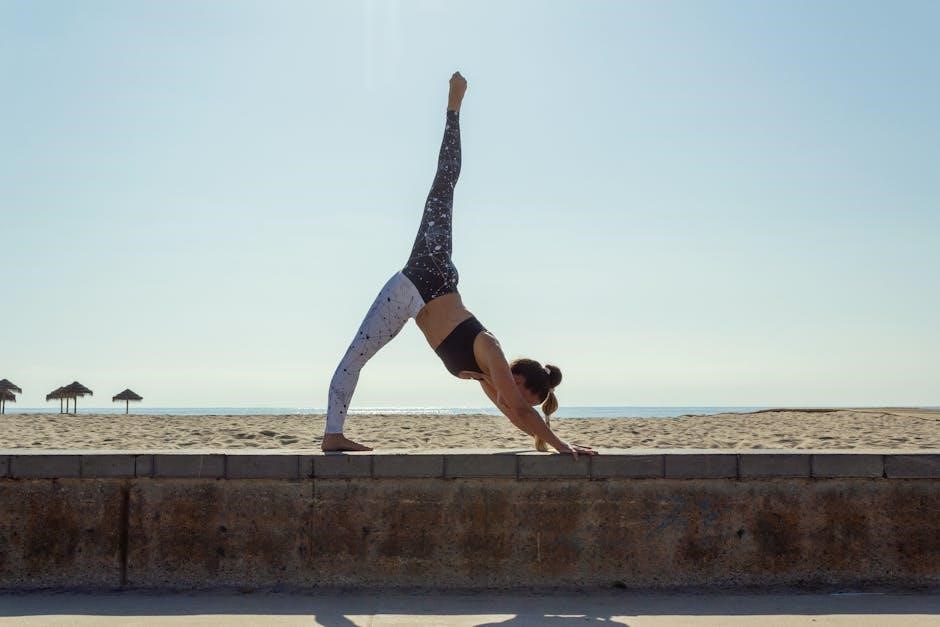
Common Mistakes to Avoid in Vinyasa Flow
- Rushing through poses without proper alignment.
- Not synchronizing breath with movement.
- Overlooking modifications for individual needs.
- Forcing beyond personal limits, risking injury.
Overexertion and Injury Prevention
Overexertion is a common mistake in Vinyasa Flow, often due to pushing too hard to keep up with the pace or ignoring physical limitations. To prevent injuries, it’s crucial to honor your body’s boundaries and avoid forcing postures. Listen to your breath and pause when needed. Modifying poses and using props can help maintain safety while still benefiting from the flow. Prioritize mindful movement over perfection to protect your joints and muscles. Proper warm-ups and cool-downs are also essential to prepare and restore the body, reducing the risk of strain or injury. Synchronizing breath with movement ensures a balanced and sustainable practice, while avoiding overexertion fosters long-term wellness and enjoyment of Vinyasa Flow yoga.
Incorrect Alignment
Incorrect alignment is a frequent mistake in Vinyasa Flow, often leading to muscle strain or injury. Practitioners may misplace their hands, feet, or spine, disrupting the pose’s integrity. To avoid this, focus on foundational postures and use props like blocks or straps to support proper positioning. Pay attention to cues from instructors and listen to your body to maintain safe and effective alignment throughout the flow.
Forgetting to Breathe
Forgetting to breathe is a common oversight in Vinyasa Flow, as the focus often shifts to movement. Neglecting breath can lead to tension, dizziness, or losing the flow’s rhythm. Encourage deep, steady breaths synchronized with transitions. Remind practitioners to inhale and exhale fully, maintaining Ujjayi breathing. Pause occasionally to refocus on breath awareness, ensuring it remains central to the practice and enhances both physical and mental benefits.
Mastery of Vinyasa Flow yoga requires dedication, awareness, and breath synchronization. Embrace the journey, explore sequences, and deepen your mind-body connection for a transformative practice experience.
Final Thoughts on Mastering Vinyasa Flow
Mastery of Vinyasa Flow yoga lies in consistency, patience, and mindfulness. By using PDF guides, practitioners can explore diverse sequences, deepen their practice, and enhance physical and mental well-being. Embrace the journey, honor your unique rhythm, and allow the flow to transform your body, breath, and spirit. Keep exploring, growing, and surrendering to the beauty of this dynamic practice.
Encouragement to Practice and Explore
Embrace your Vinyasa Flow journey with curiosity and dedication. Regular practice fosters strength, flexibility, and mental clarity. Use PDF sequences as tools to explore new flows and deepen your understanding. Celebrate small victories, honor your unique path, and trust the process. Each practice is a step toward growth—keep moving, breathing, and surrendering to the flow with an open heart and mind.
